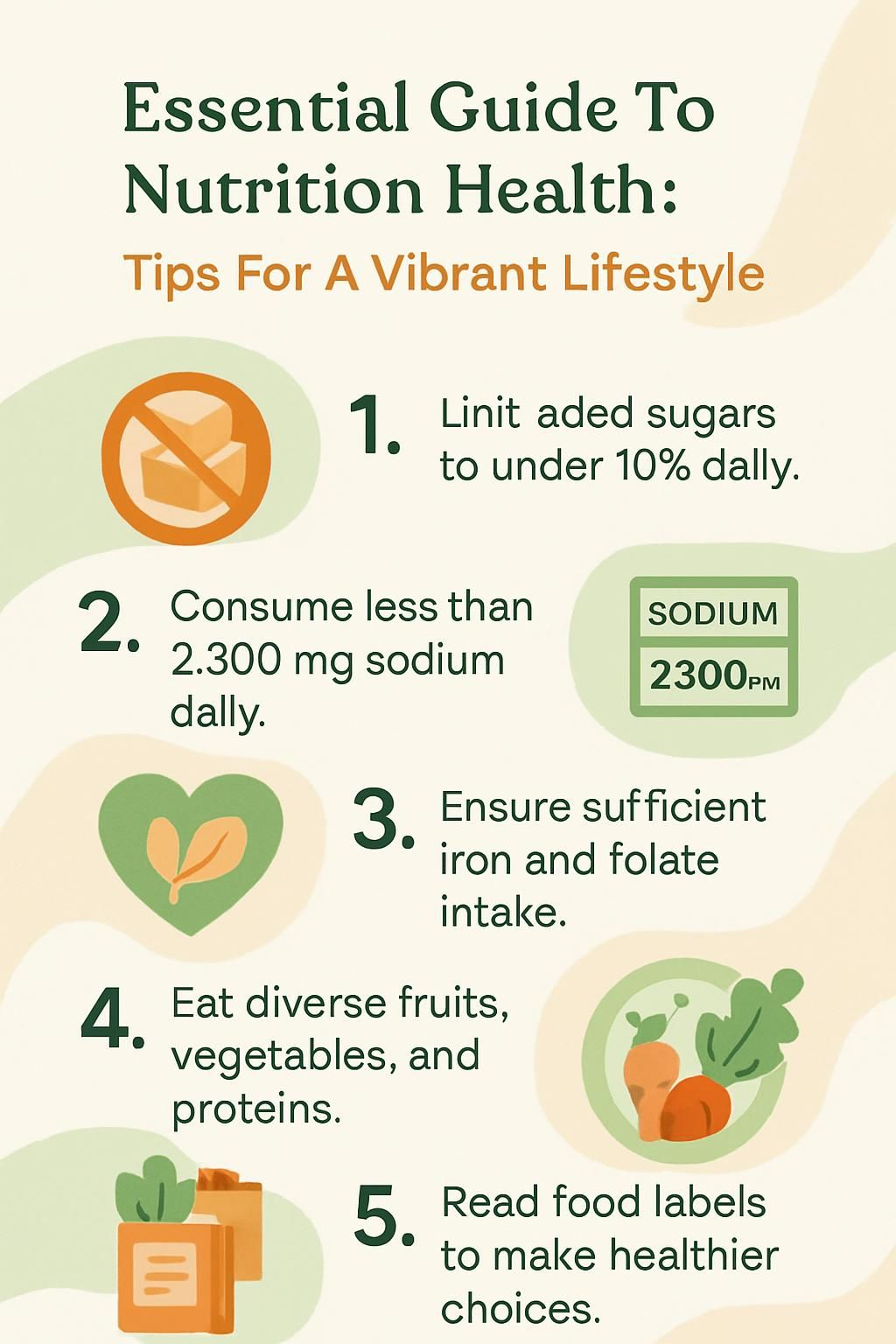Essential Guide To Nutrition Health: Tips For A Vibrant Lifestyle
Our Nutrition Assistant AI Suite will transform your body. You will lose fat, get toned, and build muscle. Gain confidence and optimal health.
You want to make healthy eating easier and feel better each day. Solid Nutrition habits can lower cholesterol, reduce your risk of heart disease, and lift your energy. Healthy eating does not have to be complex. Small changes add up fast.
This guide explains key nutrients, the Dietary Guidelines for Americans, and simple eating tips you can use right away. You will see how food and nutrition shape your mood, focus, and long-term health. This information is educational only. For personal advice, talk with a healthcare professional.
Key Takeaways
- Following the U.S. Dietary Guidelines helps lower disease risk. Keep added sugars and saturated fat under 10 percent of daily calories.
- Eat a variety of fruits, vegetables, whole grains, lean proteins, and drink water. This pattern supports immunity, energy, and mental clarity.
- Anemia affects 40 percent of children under five and 37 percent of pregnant women worldwide. Iron and folate are vital for growth and pregnancy health (World Health Organization).
- Over 1.9 billion adults live with overweight or obesity. Keeping sodium below 2,300 mg daily helps prevent high blood pressure (World Health Organization).
- Read food labels for sodium, added sugars, and types of fat. Better choices support weight control and lower chronic disease risks (FDA, FoodData Central).

What is nutrition and why is it important?

Nutrition is the process of getting energy and nutrients from foods and drinks so your body can work well. A healthy diet supports growth, cell repair, and organ function. It also lowers the chance of many diseases.
What does nutrition mean?
Nutrition means giving your body what it needs to function properly. Food provides fuel for movement and thinking, plus materials to build and protect tissues.
Your diet supplies macronutrients, which are carbohydrates, proteins, and fats. These give you energy and help repair muscles and organs. You also need micronutrients, which are vitamins and minerals that keep cells healthy and support your immune system.
A balanced intake prevents both shortages and excess. Shortages can stunt growth in children. Eating too much can raise your risk for chronic diseases in adults.
The United States Department of Agriculture recommends a pattern rich in fruits, vegetables, whole grains, lean proteins, low-fat dairy, dietary fiber, and healthy fats like olive oil and nuts. Limit added sugars and sodium.
Good nutrition is more than feeling full. It is daily protection for your health.
Steady nutrition supports learning in childhood and productivity in adulthood by helping keep blood sugar stable. Each bite fuels your day and can reduce the risk of high blood pressure or type 2 diabetes later in life.
How does nutrition affect overall health?
Nutritious meals give you energy and help every organ do its job. Adequate vitamins and minerals support bone strength, muscle repair, tissue healing, and immune defenses.
Healthy eating patterns lower risk for cardiovascular disease, diabetes, obesity, and hypertension. Globally, about 45 percent of deaths in children under five relate to undernutrition, which shows how serious poor diet can be.
Choosing nutrient-rich foods over ultra-processed items high in trans fat or added sugar improves health. Plans like the DASH diet can improve cholesterol levels and reduce disease risk.
Eating more produce and sources of omega-3 fatty acids, such as salmon, trout, or walnuts, supports brain function. Many people notice improved focus after replacing sugary snacks with beans, leafy greens, soy, whole grains, and low-fat dairy.
Small choices matter. They affect your daily energy and your long-term quality of life, according to public health agencies such as the U.S. Department of Health and Human Services.
Essential nutrients your body needs
Your body needs a mix of nutrients to stay strong and energetic. Learning the basics helps you pick healthier foods with confidence.
What are macronutrients: carbohydrates, proteins, and fats?
Macronutrients supply most of your Food energy and help build and protect tissues. You need carbohydrates, proteins, and fats in larger amounts than vitamins and minerals.
Carbohydrates are your main fuel. Whole grains, fruits, and starchy vegetables power your muscles and brain. Protein supports growth and repair. Good sources include fish, poultry, tofu, beans, lentils, and nuts.
Fats protect cells and help make hormones. Choose more unsaturated fats, such as olive oil, canola oil, avocados, nuts, and seeds. Limit saturated fat, which is mostly found in fatty meats, full-fat dairy, and some baked goods.
The USDA advises keeping saturated dietary fat under 10 percent of daily calories. Patterns like Mediterranean, DASH, or MIND focus on plant foods and lean proteins. Research links these patterns to lower rates of coronary artery disease and kidney disease.
What are micronutrients: vitamins and minerals?
Micronutrients are vitamins and minerals your body needs in small amounts, yet they do big jobs. Vitamins A, B, C, D, E, and K help skin health, energy use, and immune function.
Minerals such as calcium and magnesium support bones, nerves, and muscles. Trace minerals like zinc and iodine help cell growth and hormone balance. The World Health Organization tracks needs in early life because shortages can cause stunting and wasting.
Anemia is common worldwide. It affects 40 percent of children under five and 37 percent of pregnant women due to low iron intake. Exclusive breastfeeding in the first six months supports early nutrient needs for many infants.
Some people may need a Dietary supplement, such as iron, vitamin D, or folate. Talk with a healthcare professional first because supplements can interact with medicines and may not fit your needs.
Why is water important for nutrition?
Water supports every cell and tissue in your body. It regulates temperature, transports nutrients, and aids Digestion and absorption.
Hydration helps dissolve certain nutrients for better solubility and helps remove waste through urine and sweat. Dehydration can cause headaches, dizziness, fatigue, and trouble focusing.
Fluid needs change with age, body size, activity, and climate. Athletes and outdoor workers usually need more water, especially in heat. You can also increase fluids by eating water-rich foods like citrus fruit, cucumbers, and lettuce.
Many people find that tracking water during busy days prevents cramps and midday slumps. A simple bottle on your desk can be a helpful nudge.
What are the benefits of proper nutrition?
Eating a variety of healthy foods improves how you feel today and how you age. It supports your body and mind at every stage of life.
How does nutrition strengthen the immune system?
A balanced diet supports your immune system. Vitamins D and C and minerals like zinc and iron help your body produce and activate immune cells.
Low intake of these nutrients weakens defenses against germs. Undernutrition in young children increases infection risk and slows recovery.
Fruits, vegetables, whole grains, and nuts provide antioxidants that protect tissues from damage. Lean proteins and high-fiber foods help immune cells function well.
Public health programs often focus on nutrition to lower infection rates, especially for pregnant women and young children facing food insecurity.
How does good nutrition improve energy and performance?
Food choices shape your daily energy and how well you perform at work, school, or sports. A balanced mix of carbs, protein, and healthy fat gives steady fuel.
Whole grains provide longer-lasting energy than table sugar or fruit sugar. Lean protein helps build and repair muscles.
Hydration matters. Even mild dehydration lowers physical and mental performance. Portion control and meal prepping help prevent eating too much, which can cause sluggishness later.
Key micronutrients support endurance and recovery, including folate, magnesium, and potassium. This is helpful for people who follow vegetarian eating or lower-carb plans.
Research shows athletes need adequate protein for recovery and enough sodium to avoid cramping after hard training. Managing added sugars prevents energy spikes and crashes. Staying close to federal nutrition guidance helps prevent unwanted weight gain that can sap energy.
Sources: U.S. Department of Health and Human Services, Harvard T.H. Chan School of Public Health.
How does nutrition reduce the risk of chronic diseases?
Balanced meals help protect your heart, brain, and blood vessels over time. Mediterranean, DASH, and MIND patterns lower the risk of heart disease, stroke, type 2 diabetes, and some cancers.
Cutting sodium is key. The average American gets over 3,400 mg per day. Experts suggest staying under 2,300 mg to lower blood pressure.
Limiting saturated fat and added sugars improves cholesterol levels. It can reduce low-density lipoprotein, often called LDL or bad cholesterol, and support high-density lipoprotein, or HDL, which helps clear cholesterol.
Many processed foods pack excess sodium, sugar, and unhealthy fats that drive weight gain. Choosing whole grains, vegetables, fruit, beans, and healthy oils supports long-term health. Reading labels can reveal hidden salt and sugar so you can pick better options.
How does nutrition enhance mental clarity and mood?
Food choices affect how you think and feel. Diets rich in fruits, vegetables, and whole grains give your brain steady energy and protective nutrients.
B vitamins support attention and memory. Omega-3 fatty acids from fish, flaxseed, or walnuts can stabilize mood. Shortfalls in these nutrients may raise the risk of low mood.
Water supports brain function. Balanced meals with complex carbs, such as oats and brown rice, provide steady fuel for your brain. Many people notice better focus after eating a protein-rich breakfast with fiber.
Consistent eating habits help keep your mood steady across all ages, including older adults who are at higher risk for nutrient gaps.
Principles of nutritional health
These principles keep your food choices simple and practical. Think variety, moderation, balance, and hydration.
Why is variety important in nutrition?
Eating many types of foods gives you a wider range of vitamins, minerals, and helpful plant compounds called phytochemicals. Different colors often signal different nutrients.
Plant-focused patterns are tied to a lower risk of heart disease and diabetes. A varied diet also supports a healthy gut microbiome, which helps digestion and immunity.
Variety prevents nutrient gaps and keeps meals interesting. Trying a new whole grain or vegetable each week can make healthy eating easier to sustain.
How does moderation affect eating habits?
Moderation helps you avoid excess. U.S. guidelines suggest keeping both saturated fat and added sugar under 10 percent of daily calories.
Sodium should stay below 2,300 mg per day. Many people go well above this level.
Portion control keeps calories in check and supports weight management. Mindful eating helps you enjoy natural sweetness in fruit instead of reaching for high-calorie snacks.
Limiting highly processed foods reduces extra salt, sugar, and poor-quality fat. Many people find that reading labels and measuring typical portions cut cravings and steady energy.
What does balance mean in nutrition?
Balance means eating the right mix of macronutrients and getting enough vitamins and minerals. An easy approach is the plate method at meals.
Fill half your plate with vegetables and fruit, one quarter with whole grains, and the final quarter with lean protein. This pattern can stabilize Blood sugar level and support steady energy.
Adjust portions to fit your age, size, and activity. Quality matters more than chasing perfect macro numbers. Choose foods that nourish every Cell (biology) throughout the day.
| Meal Component | Suggested Plate Portion |
|---|---|
| Vegetables and Fruit | Half |
| Whole Grains | Quarter |
| Lean Protein | Quarter |
This method also helps you meet Mineral (nutrient) needs while keeping simple food safety habits in mind, such as chilling leftovers promptly.
Why is hydration essential?
Hydration keeps your body running well. Even a small fluid shortfall can lower mood and focus.
Water aids digestion and nutrient absorption from all food groups. Choose water over sugary drinks to support weight control and dental health.
Your needs change with age, activity level, and weather. During long workouts or hot days, you may need extra fluids and electrolytes. A short break for water can be the difference between a clear mind and a foggy one.
Dietary guidelines for a vibrant lifestyle
Use these practical steps to fuel your body and feel your best.
How can I eat more fruits and vegetables?
Aim for half your plate to be fruits and vegetables at every meal. Mix leafy greens like spinach or kale into salads, pastas, or omelets for vitamins A and C and calcium.
Choose berries for breakfast to add fiber and antioxidants. Pick cruciferous vegetables, such as broccoli, cauliflower, and Brussels sprouts, several times a week.
Prep produce on weekends. Wash, chop, and store it in clear containers so you will use it. Keep a fruit bowl on the counter to encourage quick, healthy snacks.
Focus on color variety to cover more nutrients within your calorie budget. Research links plant-forward patterns, including Mediterranean and DASH, to lower rates of heart disease and diabetes.
Why should I limit added sugars, saturated fats, and sodium?
High intake of added sugar, saturated fat, and sodium raises the risk of heart disease, stroke, and obesity. U.S. guidelines suggest keeping both added sugar and saturated fat under 10 percent of daily calories.
Adults in the United States consume over 3,400 mg of sodium per day on average, which is far above the 2,300 mg limit. High-sugar diets also track with rising childhood obesity rates.
Cut back on sugary drinks, sweets, and heavily salted snacks. Choose whole grains and lean proteins more often. Many people see quick wins in energy and weight control after these swaps.
Summary Table:
| Nutrient | Recommended Limit | Health Risk When Exceeded |
|---|---|---|
| Added Sugar | Under 10% of daily calories | Obesity, type 2 diabetes |
| Saturated Fat | Under 10% of daily calories | Heart disease |
| Sodium | Under 2,300 mg per day | High blood pressure, stroke |
How to include whole grains and lean proteins in my diet?
Swap refined grains for whole options. Choose whole-wheat bread, brown rice, quinoa, oats, or whole-wheat pasta.
Pick lean proteins such as fish, skinless poultry, beans, lentils, tofu, and a small handful of nuts. Fish adds omega-3 fatty acids that support heart health, while legumes supply fiber and folate.
Batch cook grains and proteins so weeknight meals come together fast. For breakfast, try oatmeal with fruit and walnuts for fiber and healthy fats.
What are effective ways to practice portion control?
Meal prepping helps set portions before hunger hits. Start with two or three days of meals rather than a full week so sizes stay realistic.
Use the plate method at meals. Half vegetables and fruit, one quarter whole grains, one quarter lean protein. Pre-portion snacks, such as yogurt or carrot sticks, into single servings.
Planned meals reduce impulse eating and support steady weight. The Dietary Guidelines for Americans encourage portion awareness for long-term health.
How does nutrition impact mental health?
Food choices can either cloud your mind or clear it. A steady pattern gives your brain what it needs to perform.
What is the connection between diet and mood?
Diets rich in produce and whole grains are linked with better mood and lower depression risk. Too little B vitamins or omega-3 fats may increase sadness or anxiety.
Skipping meals or eating a lot of sugar can cause blood sugar swings that affect mood and focus. Drinking enough water supports clear thinking.
Children who eat poorly often struggle with attention and learning. Regular, balanced meals help keep mood and energy more stable.
Which foods boost brain health?
Leafy greens like spinach and kale provide vitamins and plant compounds that support brain cells. Fatty fish such as salmon and sardines supply omega-3 fatty acids that aid memory and learning.
Nuts and seeds offer plant protein and healthy fat linked to better thinking skills. Whole grains, like oats and brown rice, give B vitamins for steady mental energy.
Yogurt adds protein, calcium, and probiotics that support the gut-brain connection. Berries contain antioxidants that protect brain tissue from oxidative stress.
Many experts recommend Mediterranean, DASH, or MIND eating patterns since they emphasize these brain-friendly foods.
Nutrition across life stages
Nutrient needs change as you grow. Adjust your plate to match your age and stage.
What are the nutritional needs for children and adolescents?
Kids and teens need protein for growth, carbohydrates for energy, and fats for brain and nerve development. Essential vitamins A, C, D, and E and minerals like iron and calcium are crucial.
Anemia affects 40 percent of children under five worldwide due to low iron intake. Calcium supports bone building during growth spurts in childhood and adolescence.
Malnutrition remains a major concern. More than 149 million children under five are stunted, and only 44 percent of infants younger than six months are exclusively breastfed. At the same time, childhood overweight is rising in some regions because of high intake of added sugars and poor-quality fats.
Balanced school breakfasts and snacks can improve focus and behavior. Simple options include yogurt with fruit, peanut butter on whole grain toast, or a banana with a boiled egg.
Why is nutrition important during pregnancy?
Healthy eating during pregnancy supports both mother and baby. About 37 percent of pregnant women worldwide face anemia, which raises risks for pregnancy problems.
Iron and folate are essential. Iron helps carry oxygen in the Blood, and folate supports early brain and spine development in the baby.
Meals with lean protein, whole grains, fruits, vegetables, and water support growth and a safer delivery. A prenatal vitamin may be recommended by your clinician.
What are the dietary recommendations for adults and seniors?
Adults should emphasize fruits, vegetables, whole grains, and lean proteins. Limit saturated fat and added sugar to under 10 percent of daily calories. Keep sodium under 2,300 milligrams per day.
Adults over 50 face higher risks for both malnutrition and obesity. Poor choices increase the chance of heart disease, diabetes, stroke, and some cancers.
Plan meals, control portions, and choose minimally processed foods. Many older adults find that prepping salads, soups, or grain bowls reduces temptation to order takeout and helps manage weight.
What are some tips for improving your nutritional health?
Simple habits done often make the biggest difference. Start small, stay consistent, and build on wins.
How to read food labels for better choices?
Check the Nutrition Facts panel for serving size, calories, and key nutrients. Focus on added sugars, saturated fat, and sodium.
Scan the ingredient list. Choose products with whole grains listed first. Shorter lists often mean less processing.
Use the FoodData Central database for detailed nutrition information if you need it. For supplements, the FDA regulates claims but does not verify content. Ask your healthcare provider before using any supplement regularly.
Comparing similar items side by side can reveal large differences in salt or sugar. Use labels to pick healthier options without guesswork.
Why is cooking at home beneficial?
Cooking at home gives you control over ingredients and portion sizes. Home meals usually include less added sugar, salt, and poor-quality fat than takeout or restaurant food.
Meal prepping reduces stress and saves money. Trying new, nutritious recipes, such as whole grain waffles or hearty bean chili, can keep healthy eating enjoyable.
Cooking with family builds skills and makes everyone more engaged in Nutrition Health.
How to plan meals ahead effectively?
Pick a planning day. Choose recipes that fit your time and budget. Start with two to three days of meals to avoid waste.
Keep staples on hand, such as whole grains, frozen vegetables, canned beans, and eggs. Label containers with the meal and date so portions stay clear.
Cook items with longer times first, like brown rice or lentils, while you chop produce. Planning ahead helps you skip ultra-processed foods and maintain a balanced pattern.
How to make gradual, sustainable dietary changes?
Set small goals you can keep. Add one serving of vegetables to dinner. Swap white bread for a whole grain option. Choose water instead of soda a few times a week.
Track progress in a simple food diary or app. Reduce foods high in saturated fat, added sugar, and sodium one meal at a time. Meeting with a registered dietitian can help personalize your plan and keep you motivated.
Common myths about nutrition
Nutrition myths spread fast. Clear facts help you focus on what works.
What are popular diet misconceptions?
There is no single best diet for everyone. Food quality matters more than strict macronutrient ratios.
Most healthy adults can meet needs without a Multivitamin if they eat a balanced diet. Many diet foods still contain added sugars, sodium, or poor-quality fats. Reading labels helps you avoid surprises.
Both plant-based and traditional patterns can be healthy when you include variety, balance, and moderation. Not all processed foods are harmful, but watch for excess salt and sugar.
What is the truth about “superfoods”?
Some foods are very nutrient dense, such as berries, leafy greens, fatty fish, yogurt, beans, and nuts. They deliver vitamins, minerals, fiber, and healthy fats that support heart, brain, and gut health.
Still, no single food meets all needs. Your best strategy is a varied diet built on whole foods, with room for personal taste and culture.
The role of physical activity in nutrition health
Food fuels your movement, and movement helps your body use that fuel well.
How does exercise complement a healthy diet?
Regular activity reduces risk for chronic conditions like heart disease and type 2 diabetes. Good nutrition powers your workouts and speeds recovery afterward.
Protein supports muscle repair. Whole grains provide steady energy. Water prevents dehydration, which can limit performance and slow recovery.
Even short walks paired with balanced meals can raise daily energy and mood.
What are the nutritional needs for active people?
Active people need enough carbohydrates for fuel, protein for muscle repair, and healthy fat for hormone balance and vitamin absorption. Needs vary by age, body size, and type of activity.
Endurance training often requires more carbohydrates. Strength training usually needs more protein. Hydration is crucial before, during, and after exercise.
Some athletes benefit from electrolytes in long or hot workouts. Personalizing your meals to your training can prevent fatigue and lower injury risk.
Consulting professionals for nutrition guidance
Expert support can make your plan safer, clearer, and easier to follow.
What are the benefits of working with a registered dietitian?
A registered dietitian can tailor Nutrition advice to your health needs and preferences. They help you balance macronutrients and meet vitamin and mineral goals.
Dietitians can also help manage conditions like diabetes or heart disease. They teach label reading, meal planning, and smart swaps you can live with.
This partnership can improve confidence and outcomes across all life stages, from pregnancy to healthy aging.
When should I seek nutrition advice from a healthcare provider?
Seek help if you have obesity, high blood pressure, heart disease, or diagnosed deficiencies. Pregnant or breastfeeding women have special needs and benefit from expert guidance.
People with osteoporosis may need extra nutrients. Vegans should discuss vitamin B12 and other potential gaps. Adults over 50 may need support as metabolism changes.
Professional advice ensures your plan is safe and effective for your medical history.
The environmental impact of nutrition
Your plate affects land, water, and emissions. Small shifts can support both your health and the planet.
How to choose sustainable food options?
Support local farmers when possible to reduce travel distance. Shift meals toward plant-based dishes that are linked to lower environmental impact and health benefits.
Choose nutrient-dense foods such as fruits, vegetables, whole grains, and legumes. Limit ultra-processed items that often carry higher environmental costs.
Cook with seasonal ingredients to cut waste. If you need help, a registered dietitian can suggest eco-friendly choices that fit your goals.
How can I reduce food waste?
Plan meals and shop with a list. Prep ingredients early in the week so you use what you buy.
Label leftovers with dates, and store older items at the front of the fridge. Keep versatile staples like rice, beans, and pasta on hand for quick mix-and-match meals.
Use the whole ingredient when you can. Save vegetable trimmings to make stock. Frozen produce has a longer shelf life and reduces spoilage.
How to stay motivated on your nutrition journey?
Motivation grows with clear goals and steady wins. Make progress visible and celebrate it.
How to set realistic nutrition goals?
Start by observing your current habits for one week. Use a simple journal or app. Learn the basics from trusted sources like Nutrition.gov or the DASH diet if high blood pressure runs in your family.
Set small, specific goals. Swap soda for water at lunch. Add a serving of vegetables to dinner. Visit local markets to try new produce without overspending.
Consider meeting with a registered dietitian for a plan that fits your life. Support makes change easier to maintain.
How to track progress and celebrate milestones?
Track daily intake, water, and movement. Use meal prepping as a milestone to make healthy eating automatic.
Create short-term targets, such as three home-cooked dinners per week or a week without sugary drinks. Celebrate with non-food rewards like a new water bottle or sharing your wins with a friend.
Review monthly and adjust goals as needed. These steps build confidence and keep your momentum strong.
Conclusion
Small, steady changes lead to a vibrant lifestyle. Focus on whole foods, water, and portion control. This approach supports heart health, boosts energy, and lowers disease risk.
Your needs shift across life stages, so adjust your plate as you age. For credible guidance, visit Nutrition.gov or speak with a healthcare professional. Start today with one simple change, then build from there. Your body and mind will thank you for the care you give them.
FAQs
1. What are the main components of a balanced diet for vibrant health?
A balanced eating plan includes whole grains, lean proteins such as chicken or fish, healthy fats like olive oil, fruits, and vegetables. Research from the Centers for Disease Control and Prevention shows that people who eat more plant-based foods have lower risks of heart disease and diabetes.
2. How can I use nutrition facts to make better food choices?
Reading nutrition labels helps you compare calories, sugar content, sodium levels, fiber amounts, and protein in different products. For example, a study published in JAMA found that adults who read food labels tend to consume fewer unhealthy fats and added sugars.
3. Why is hydration important for overall wellness?
Water supports digestion; it also regulates body temperature and helps transport nutrients throughout your system. According to the National Academies of Sciences, most adults need about 11-16 cups of water each day depending on activity level.
4. Can small changes in daily meals improve long-term health outcomes?
Yes; swapping sugary drinks with water or choosing brown rice instead of white rice can reduce calorie intake over time. In my own experience as a parent preparing family meals with more vegetables led to higher energy levels during busy weeks at work and school.
Summary: Eating varied foods rich in nutrients supports good health while reading nutrition information empowers smarter decisions at every meal. Drinking enough water keeps your body working well; even simple swaps create lasting benefits when practiced consistently.







